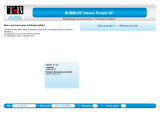
Bottom cover ..................................................................................................................................... 26
USB/audio board ................................................................................................................................ 29
WLAN module .................................................................................................................................... 30
WWAN module ................................................................................................................................... 32
Solid-state drive (M.2) ....................................................................................................................... 34
Hard drive .......................................................................................................................................... 35
RTC battery ........................................................................................................................................ 38
Memory module ................................................................................................................................ 40
Power button board .......................................................................................................................... 42
Fan ..................................................................................................................................................... 44
Heat sink ............................................................................................................................................ 46
Battery ............................................................................................................................................... 48
Speakers ............................................................................................................................................ 49
TouchPad button board ..................................................................................................................... 50
Display assembly ............................................................................................................................... 52
Power connector cable ...................................................................................................................... 58
System board .................................................................................................................................... 59
Keyboard ........................................................................................................................................... 62
6 Using Setup Utility (BIOS) in Windows 10 ....................................................................................................... 64
Starting Setup Utility (BIOS) ................................................................................................................................ 64
Updating Setup Utility (BIOS) .............................................................................................................................. 64
Determining the BIOS version ........................................................................................................... 64
Downloading a BIOS update .............................................................................................................. 65
Synchronizing a tablet and keyboard (select products only) .............................................................................. 66
7 Using Setup Utility (BIOS) in Windows 8.1 ...................................................................................................... 67
Starting Setup Utility (BIOS) ................................................................................................................................ 67
Updating the BIOS ................................................................................................................................................ 67
Determining the BIOS version ........................................................................................................... 67
Downloading a BIOS update .............................................................................................................. 68
Synchronizing a tablet and keyboard (select models only) ................................................................................ 69
8 Using HP PC Hardware Diagnostics (UEFI) ....................................................................................................... 70
Downloading HP PC Hardware Diagnostics (UEFI) to a USB device .................................................................... 71
9 Backing up, restoring, and recovering in Windows 10 ..................................................................................... 72
Creating recovery media and backups ................................................................................................................ 72
Creating HP Recovery media (select products only) ......................................................................... 72
Using Windows tools ........................................................................................................................................... 73
vi























